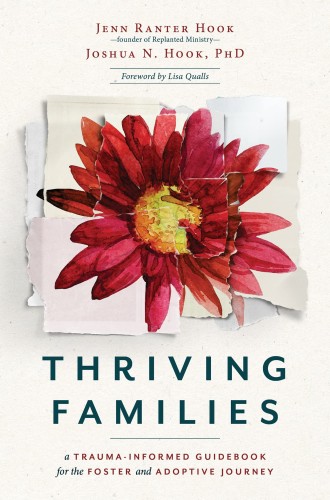Is being adopted or fostered always traumatic?
Jenn Ranter Hook and Joshua Hook say yes—and offer families concrete tools to support children.
Midway through Thriving Families, the authors tell the story of a young boy named Damen. Joanne and Tom, who have been his foster parents for a year and a half, are thrilled when they learn that they can legally adopt him. They decide to throw an “adoption day party,” a celebration with close friends that presumes Damen is joyful about his adoption. Damen, however, refuses to come out of his room on the day of the party. He later says that the day of his adoption was one of the “saddest days of his life” because it meant he had to give up his hopes of returning to his birth home. Damen’s story displays not only the reality of adoptee grief but also the importance of adoptive parents acknowledging it—which is one of the main themes running through the book.
Thriving Families is essential reading for all prospective and current adoptive and foster parents, as well as those who support them. Coauthors Jenn Ranter Hook and Joshua Hook dive into misconceptions about adoption, share powerful anecdotes about family situations, equip parents with concrete ways to support adopted and fostered children, and prime readers for further conversation by offering thoughtful questions at the end of each chapter. They do more than state theory about how to create a successful family; they help readers do the work.
The Hooks believe that fostering and adoption always entail some level of trauma for the child; thus, they aim to reeducate parents from a trauma-informed perspective. Adopted and fostered children are more susceptible to physical, emotional, and mental struggles than other children. The Hooks offer a comprehensive explanation of this phenomenon, based on Jenn’s years of experience as a social worker for children in foster care.
For any parents to support their children, they first need to understand their own family upbringing and reflect on how it impacts their parenting. The guidebook format of Thriving Families is especially constructive in this respect. It encourages parents to look inward at their motivations for desiring parenthood and apply what they learn to the particularities of their current context. The authors emphasize how crucial emotional empathy work is in the vocation of raising children—and how difficult it can be. As Damen’s story illustrates, it takes practice to hold difficult emotions with children. An impulse to protect the child from negative feelings can cause parents to ignore, invalidate, or downplay the child’s grief, sadness, and anger.
Acknowledging and holding negative emotions with adopted and fostered children also means addressing their trauma, which often leads to talking about their birth family. Some parents may feel insecure or threatened when discussing the birth parents, but the authors clearly state that adults need to work through those emotions for the sake of their children. “The birth family will always be a reality in your child’s life—this is part of the adoption or foster care process. It doesn’t mean your child values you less; rather, this is a normal process of development. If you feel threatened by that exploration, consider processing those feelings with a counselor so it does not hinder your relationship with your child and their birth family.”
The Hooks also offer advice about how to talk with adopted or fostered children about their birth parents. “Allow your child to form opinions and views about their birth family without influencing their narrative. Support the goal of reunification if possible. . . . All people are worthy of love and respect, regardless of their choices or the mistakes they have made.”
These suggestions are rooted in the authors’ belief that the purpose of adoption and foster care extends beyond individual family units. They believe that we must “broaden our definition of family to include not only our adoptive and foster children but also our children’s biological family.” As an adoptee, I agree that this kind of expansive thinking is necessary in our culture. Adoption or foster care is not just about one child joining one family; it’s about families opening their hearts to support and care for other families—community caring for the community.
The authors of this book were neither adopted nor fostered as children, and they have not given up a biological child for adoption. Still, they do a good job of advocating from multiple perspectives. Much of the popular narrative on foster care and adoption comes from adults who see themselves as gaining and helping children. Little is understood from the perspective of birth families or the children removed from their families. Thriving Families makes space for the stories of the many parties involved in adoption and foster care.
The authors do a wonderful job portraying the typical experiences around domestic same-race adoptions in the United States. For families who adopt across racial lines or national borders, however, I recommend seeking additional resources. International and transracial adoptions pose unique issues. Some transracial adoptees are now telling their stories and analyzing their experiences, and there are multiple ways parents can educate themselves about the history, language, and culture of an adoptee’s birth country.
When it comes to creating a strong foundation for children, knowledge is power—and this is especially the case in adoptive and foster families. Thriving Families is an excellent source of knowledge. By taking seriously the weight of choosing parenthood and the role of trauma in adoption and foster care, the Hooks provide readers with tools to build healthier families.






